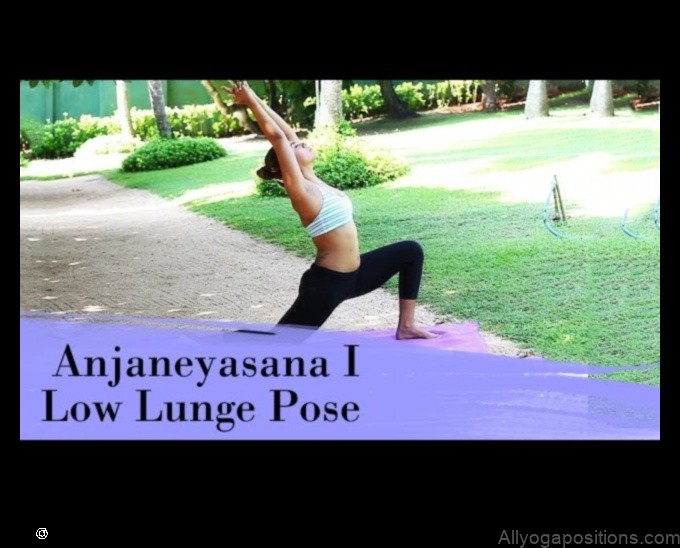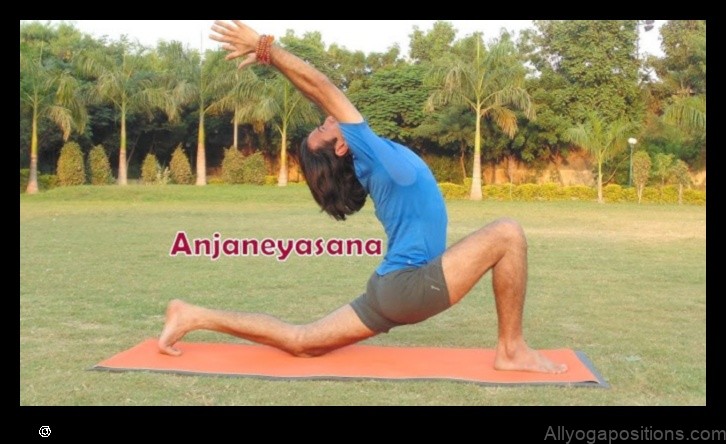
Anjaneyasana Yoga Pose
Anjaneyasana, also known as monkey pose, crescent lunge, or low lunge, is a standing forward bend that is said to resemble the stance of a monkey. It is a popular pose in yoga because it is relatively easy to do and provides a number of benefits, including stretching the hamstrings, calves, and groin; strengthening the core and back; and improving balance.
This article will provide a detailed guide to how to do Anjaneyasana, as well as information on its benefits, variations, contraindications, and more.
Benefits of Anjaneyasana
Anjaneyasana offers a number of benefits, including:
- Stretches the hamstrings, calves, and groin
- Strengthens the core and back
- Improves balance
- Reduces stress and anxiety
- Increases flexibility
- Improves circulation
- Aids digestion
How to do Anjaneyasana
To do Anjaneyasana, follow these steps:
- Stand with your feet hip-width apart and your arms at your sides.
- Step forward with your right leg, and bend your knee so that your right thigh is parallel to the floor.
- Reach your left arm up overhead, and extend your right arm behind you.
- Inhale and lengthen your spine.
- Exhale and fold forward from your hips, keeping your right knee bent and your left leg straight.
- Reach your arms forward, and rest your hands on the floor in front of you or on your shins.
- Hold the pose for 5-10 breaths.
- To come out of the pose, inhale and straighten your legs.
- Step back to your starting position.
It is important to listen to your body and modify the pose as needed. If you have any pain in your knees, ankles, or back, do not go as deep into the pose. You can also try placing a block under your hands for support.
Common Mistakes in Anjaneyasana
There are a few common mistakes that people make when doing Anjaneyasana, including:
- Not keeping your back flat
- Bending your back knee too much
- Rounding your shoulders
- Overstretching your hamstrings
To avoid these mistakes, make sure to:
- Keep your back flat by engaging your core muscles
- Bend your front knee only as much as you can without pain
- Keep your shoulders back and down
- Stretch your hamstrings slowly and gradually
Modifications for Anjaneyasana
If you have any pain in your knees, ankles, or back, there are a few modifications that you can make to Anjaneyasana:
- Instead of bending your front knee, keep it straight and place your foot on a block or chair
- Place a rolled-up towel under your knee for support
- Come down to your knees instead of standing
- Hold onto a wall or chair for support
| Anjaneyasana | Monkey pose |
|---|---|
| Also known as: | Crescent lunge |
| How to do: | Step 1: Stand with your feet hip-width apart. |
| Common mistakes: | Rounding your back |
| Modifications: | Place a block under your hands |
II. Benefits of Anjaneyasana
Anjaneyasana is a versatile pose that offers a number of benefits, including:
- Stretches the hamstrings, calves, and groin
- Strengthens the core, glutes, and thighs
- Improves balance and coordination
- Reduces stress and anxiety
- Increases flexibility
- Improves blood circulation

III. How to do Anjaneyasana
To do Anjaneyasana, follow these steps:
- Stand with your feet hip-width apart and your toes facing forward.
- Bend your right knee and step your right foot back so that your right heel is in line with your left ankle.
- Reach your arms overhead and clasp your hands together.
- Inhale and extend your left leg behind you, keeping your left knee straight.
- Exhale and bend forward from your hips, reaching your torso toward your right shin.
- Keep your right knee bent and your left leg extended.
- Rest your hands on your shin or ankle, or extend them forward along the ground.
- Hold the pose for 5-10 breaths, then release and return to standing.
- Repeat on the other side.
IV. Common Mistakes in Anjaneyasana
Here are some common mistakes to avoid when doing Anjaneyasana:
- Not engaging your core. When you’re in Anjaneyasana, it’s important to engage your core muscles to support your back and prevent injury.
- Rounding your back. In Anjaneyasana, you should keep your back straight and avoid rounding it. This will help to protect your spine and prevent injury.
- Overextending your back. In Anjaneyasana, you should not overextend your back. This can put strain on your spine and lead to injury.
- Bending your knees too much. In Anjaneyasana, you should keep your knees slightly bent. This will help to protect your knees and prevent injury.
- Forcing your head to the ground. In Anjaneyasana, you should not force your head to the ground. This can put strain on your neck and lead to injury.

V. Modifications for Anjaneyasana
There are a few modifications that can be made to Anjaneyasana to make it more accessible for those with limited flexibility or strength.
- For those who cannot reach their foot to their hand, you can use a strap to bring your foot closer to your hand.
- If you have difficulty balancing in the lunge position, you can place your hands on a block or chair for support.
- If you have knee pain, you can bend your knee slightly or place a rolled-up towel under your knee for support.
By making these modifications, you can still reap the benefits of Anjaneyasana without putting yourself at risk of injury.
6. Benefits of Practicing Anjaneyasana Daily
Anjaneyasana is a versatile yoga pose that offers a variety of benefits, including:
- Strengthens the legs, hips, and core
- Improves flexibility in the spine and hamstrings
- Increases blood flow to the brain
- Reduces stress and anxiety
- Promotes relaxation
- Improves balance and coordination
VII. Yoga Sequences with Anjaneyasana
Anjaneyasana can be incorporated into a variety of yoga sequences, both as a standalone pose and as part of a flow. Here are a few examples of yoga sequences that include Anjaneyasana:
-
Sun Salutation A: Anjaneyasana is the second pose in Sun Salutation A. This sequence is a great way to warm up your body and start your yoga practice.
-
Warrior 3 to Anjaneyasana: Start in Warrior 3 pose. From here, step your back foot forward and lower your body into Anjaneyasana. Hold for 5-10 breaths, then return to Warrior 3. Repeat this sequence on the other side.
-
Downward-Facing Dog to Anjaneyasana: Start in Downward-Facing Dog pose. From here, step your right foot forward between your hands and lower your body into Anjaneyasana. Hold for 5-10 breaths, then return to Downward-Facing Dog. Repeat this sequence on the other side.
Anjaneyasana can also be incorporated into more advanced yoga sequences, such as Ashtanga yoga and Vinyasa yoga. If you are new to yoga, it is best to start with a beginner-friendly sequence that includes Anjaneyasana.
Benefits of Practicing Anjaneyasana Daily
VIII. Benefits of Practicing Anjaneyasana Daily
Anjaneyasana is a versatile yoga pose that offers a variety of benefits, including:
- Increased flexibility in the hips, hamstrings, and lower back
- Strengthened core and legs
- Improved balance and coordination
- Reduced stress and anxiety
- Improved circulation
- Enhanced digestion
- Increased energy levels
If you are looking for a yoga pose that can help you improve your overall health and well-being, Anjaneyasana is a great option. It is a relatively easy pose to learn, and it can be practiced by people of all ages and fitness levels.
To get the most benefits from Anjaneyasana, it is important to practice it regularly. Aim to do the pose at least three times per week, and gradually increase the length of time you hold the pose each time. You can also add variations to the pose to make it more challenging or to target specific areas of the body.
If you have any underlying health conditions, be sure to talk to your doctor before starting a yoga practice. Anjaneyasana is generally safe for most people, but there are some cases where it may not be advisable.
FAQ
Q: What are the benefits of practicing Anjaneyasana daily?
A: Anjaneyasana has many benefits, including:
- Strengthening the legs and core
- Stretching the hamstrings, calves, and back
- Improving balance and flexibility
- Releasing tension in the lower back
- Promoting circulation
- Reducing stress and anxiety
Q: What are some common mistakes people make when doing Anjaneyasana?
A: Some common mistakes people make when doing Anjaneyasana include:
- Rounding the back
- Overstretching the hamstrings
- Pressing down on the knee
- Not engaging the core
Q: What are some modifications for Anjaneyasana?
If you are new to yoga or have any knee or back injuries, there are a few modifications you can make to Anjaneyasana:
- Place a block under your foot to make it easier to reach the ground
- Bend your knee slightly and keep your foot flat on the ground
- Rest your hand on your shin or thigh instead of reaching up to the sky
Q: What are the contraindications for Anjaneyasana?
Anjaneyasana should not be performed if you have any of the following conditions:
- Pregnancy
- Recent knee or back injury
- High blood pressure
- Glaucoma
Q: How can I make Anjaneyasana more challenging?
If you are an experienced yoga practitioner, there are a few ways to make Anjaneyasana more challenging:
- Hold the pose for longer
- Lift your leg higher in the air
- Reach your arm further back
- Add a weight to your ankle
Q: What is the best time of day to practice Anjaneyasana?
Anjaneyasana can be practiced at any time of day, but it is best to practice it in the morning or early afternoon.
Q: What other yoga poses can I do with Anjaneyasana?
Anjaneyasana can be paired with a variety of other yoga poses, including:
- Downward-facing dog
- Upward-facing dog
- Warrior I
- Warrior II
- Triangle pose
Q: What are the benefits of practicing Anjaneyasana daily?
Anjaneyasana has many benefits, including:
- Strengthening the legs and core
- Stretching the hamstrings, calves, and back
- Improving balance and flexibility
- Releasing tension in the lower back
- Promoting circulation
- Reducing stress and anxiety
Q: What is the difference between Anjaneyasana and other yoga poses that stretch the hamstrings?
Anjaneyasana is similar to other yoga poses that stretch the hamstrings, such as:
- Downward-facing dog
- Upward-facing dog
- Warrior I
- Warrior II
- Triangle pose
However, Anjaneyasana is unique in that it also strengthens the legs and core, and it can help to release tension in the lower back.
FAQ
Q: What are the benefits of practicing Anjaneyasana daily?
A: Anjaneyasana has a number of benefits, including:
- Strengthens the legs, hips, and core
- Improves flexibility in the hamstrings and back
- Relieves stress and tension
- Improves balance and coordination
Q: What are some common mistakes people make when doing Anjaneyasana?
A: Some common mistakes people make when doing Anjaneyasana include:
- Rounding the back
- Overextending the back knee
- Pressing down on the head
Q: What are some modifications for Anjaneyasana?
A: If you are unable to do Anjaneyasana with your legs straight, you can try doing it with your knees bent. You can also place a block under your hands for support.
Table of Contents
